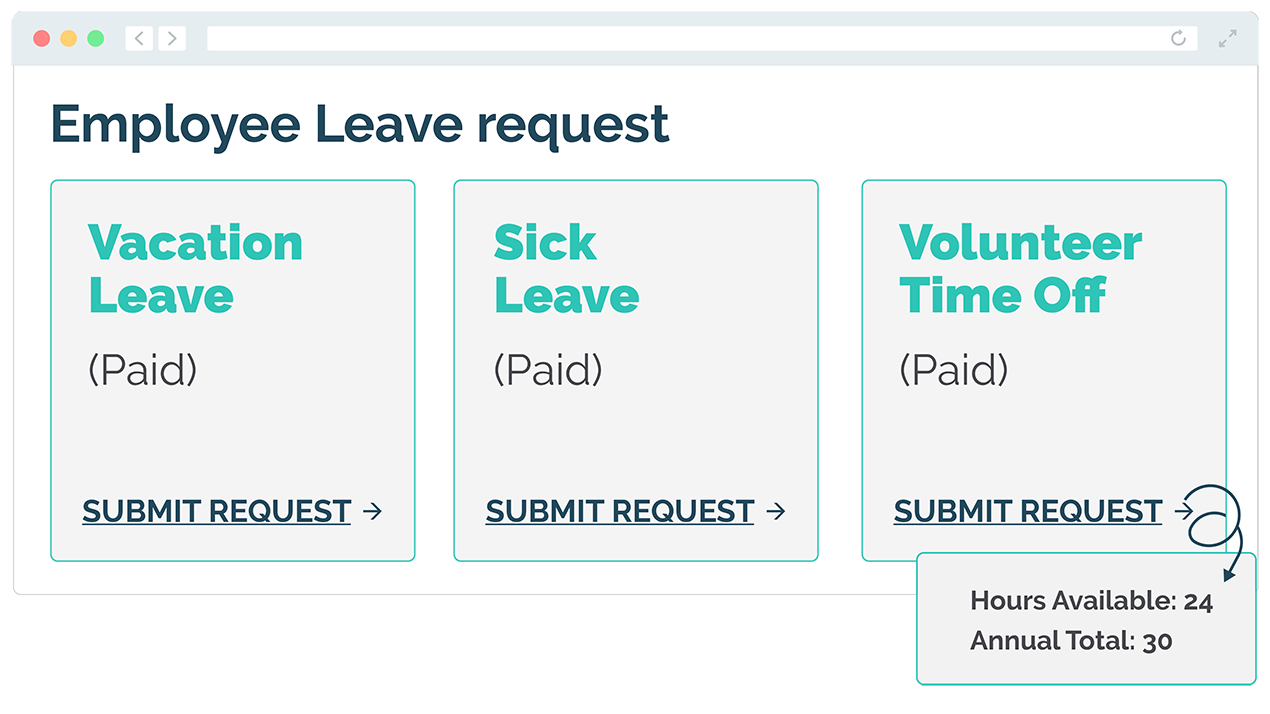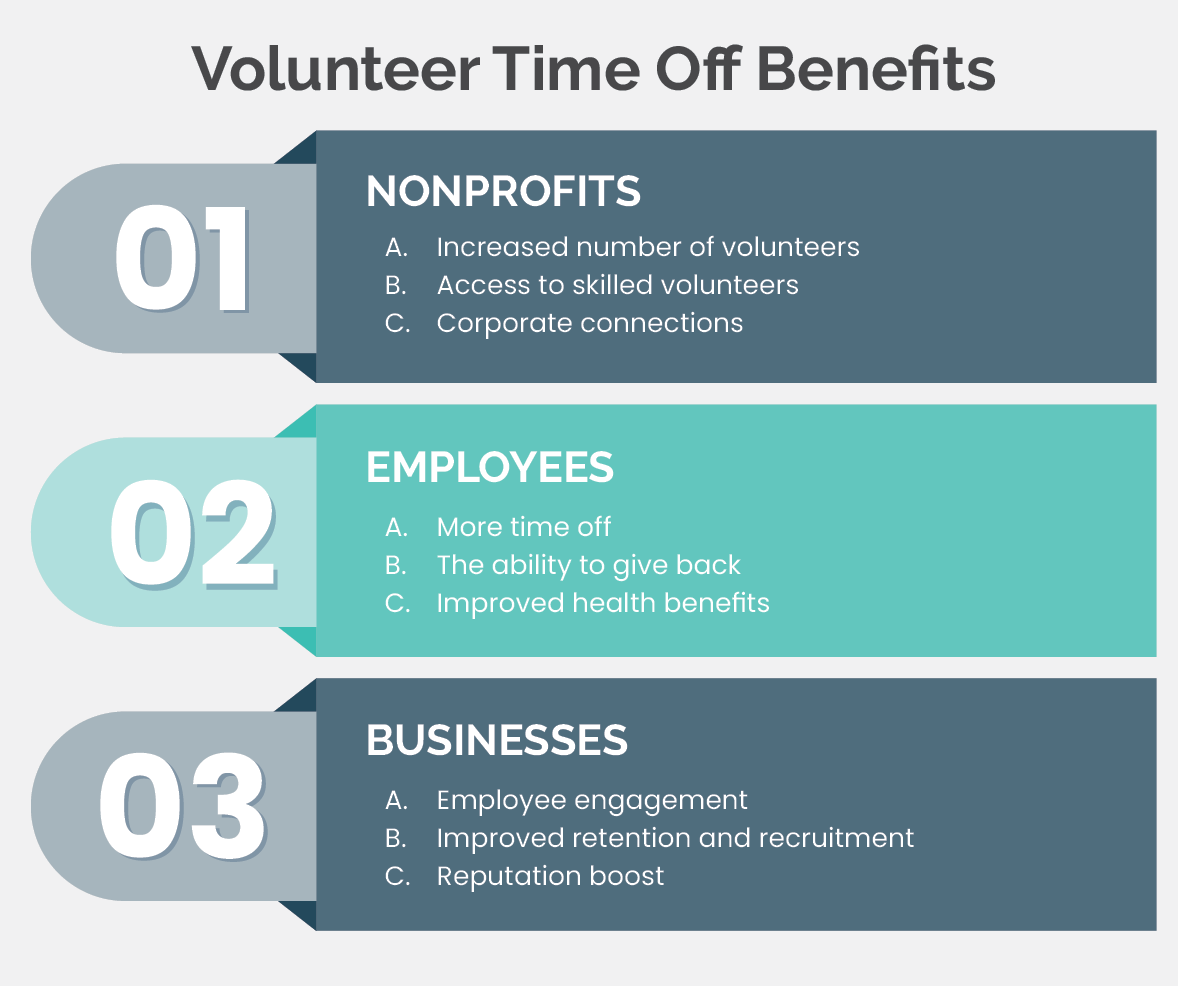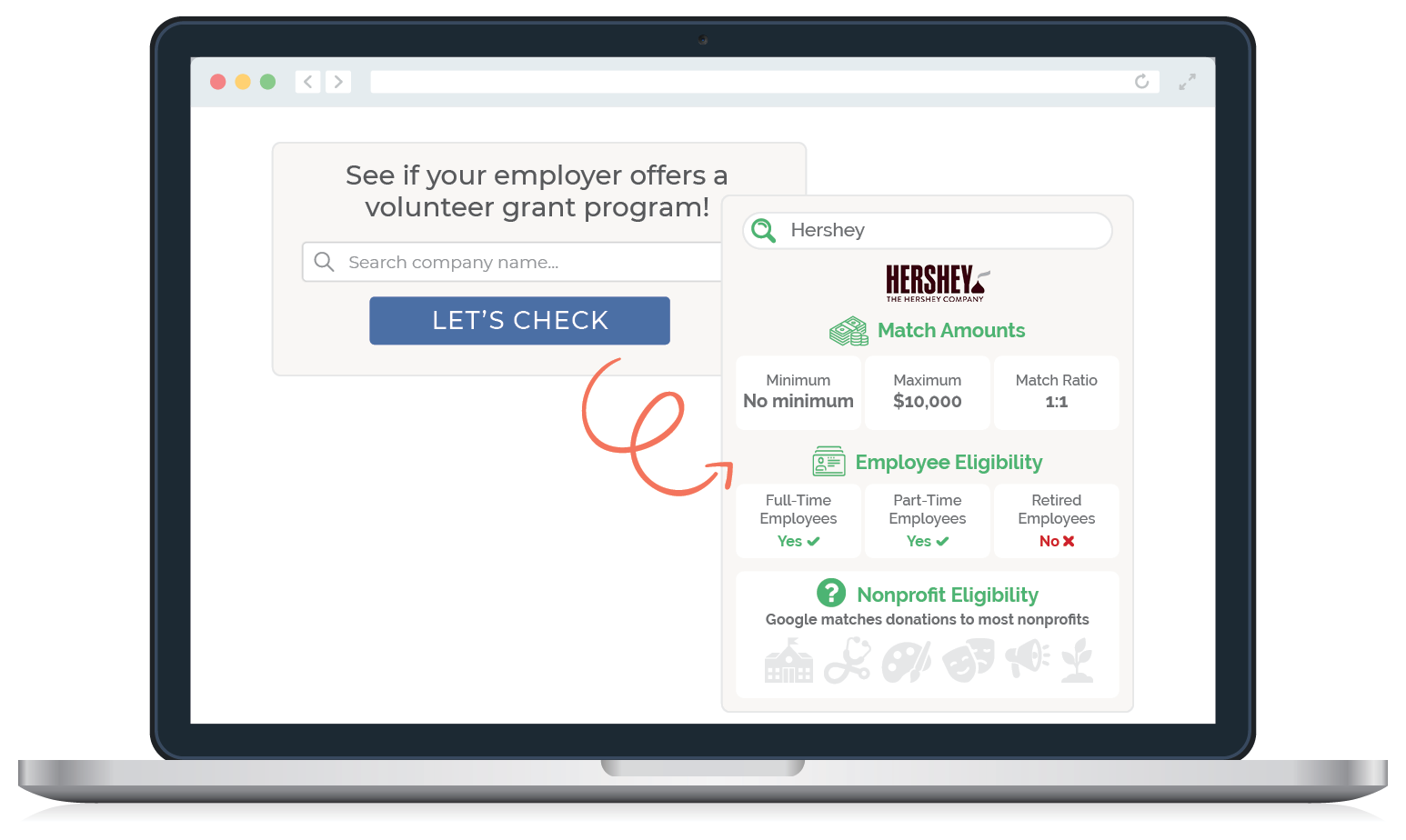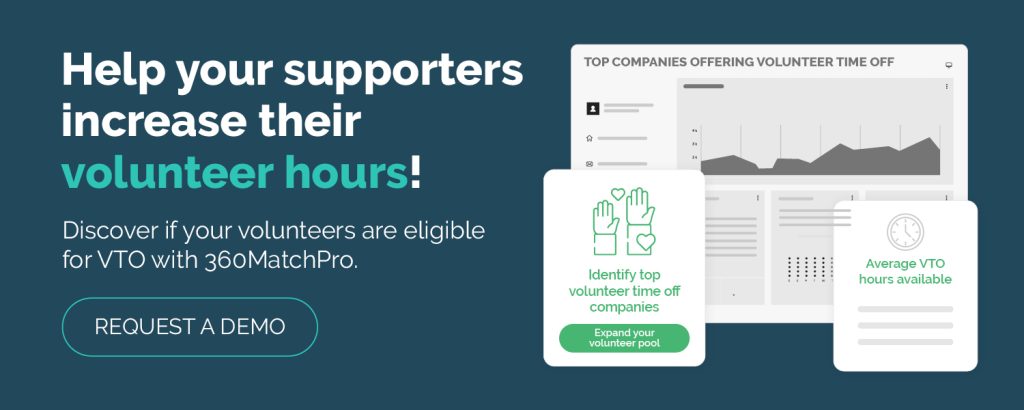
As part of their corporate philanthropy and employee engagement efforts, many businesses provide employees with benefits and programs that help them give back to their communities. This might be a way to make donating more convenient, like payroll deductions, or support for charitable giving, like matching gifts.
One corporate benefit on the rise is volunteer time off (VTO). With VTO, nonprofits can gain highly skilled, professional volunteers to help out during regular business hours.
In this guide, we’ll show how nonprofits can leverage these programs and secure volunteers by exploring these topics:
- Volunteer Time Off FAQ
- Volunteer Time Off Benefits
- How to Encourage Volunteer Time Off
Your volunteers are incredibly valuable, and with a successful VTO education strategy, you can attract even more of them. Let’s start our exploration of VTO with an overview of top questions about these programs.
Volunteer Time Off FAQ
What is volunteer time off?
Volunteer time off is a type of corporate volunteerism where employees are given a set amount of paid time off hours specifically for volunteering. For example, an employee might request Earth Day off to volunteer with a nonprofit that restores environments by planting trees and picking up trash.
A few other types of corporate volunteerism include:
- Volunteer grants
- Corporate volunteer days
- In-kind service donations
- Mentorships
- Employee internships
Volunteer time off is not to be confused with voluntary time off, though both terms share the acronym VTO. Voluntary time off is unpaid leave workers can use to have time off from work but retain their employment and benefits. Commonly, companies that have busy seasons will use voluntary time off policies. This allows them to keep a large number of employees on staff but only schedule them when needed.
Is volunteer time off paid?
Yes. VTO is a benefit and is included in employees’ compensation packages. Most companies that offer VTO will divide employee paid time off into multiple categories, such as regular PTO, sick time, and VTO.

However, some companies have VTO policies where hours accrued for it expire at the end of the fiscal year. This encourages employees to be active in their volunteering but can also result in employees losing out on one of their benefits.
What is the difference between volunteer time off and paid time off?
Volunteer time off is a type of PTO. However, while PTO can generally be used for any activity, VTO must exclusively be used for volunteering. As such, VTO requests often require employees to report what types of activities they will be performing to avoid misuse.
Some types of volunteer work may not fall under the purview of VTO, and employees would need to take regular PTO to receive time off to do them. Usually, companies permit employees to volunteer with any type of nonprofit, except for political and religious organizations and organizations related to family members. This means if an employee wants to take time off to canvas for a political candidate or coach their kid’s baseball team, they would likely need to request PTO rather than VTO.
Of course, every company’s VTO policy is unique, and some businesses may be more or less flexible with what is and is not allowed for VTO.
Volunteer Time Off Benefits
The number of VTO programs is on the rise due to every party involved receiving significant benefits. Here’s an overview of what nonprofits, employee volunteers, and businesses can expect from VTO programs:

Nonprofits
- Increased number of volunteers. 30% of volunteers help out at nonprofits simply because they have the time to do so. Work commitments are a major obstacle to volunteering for many people, especially those who want to volunteer during typical 9-to-5 work hours rather than on weekends or evenings. With VTO, these supporters would have the time to volunteer, increasing your total number of volunteers.
- Access to skilled volunteers. Many companies that offer VTO are major corporations with highly skilled workforces. For example, a few top VTO companies include technology company Cisco, pharmaceutical giant Johnson & Johnson, and global financial services firm Deloitte.
- Corporate connections. If many employees from one company volunteer with your nonprofit, that could lead to the start of a corporate partnership. Business leadership might take notice of their employees’ volunteer efforts or your volunteers might recommend your nonprofit for philanthropic initiatives, like sponsorships.
Employees
- More time off. VTO is ultimately paid time off, which many employees appreciate even if they don’t regularly volunteer. Those looking to get out of the office for a day may enjoy the change in scenery and get inspired to help nonprofits that are new to them.
- The ability to give back. Employees who feel strongly about a cause and want to volunteer regularly may purposefully seek out employers that offer generous VTO policies. This allows these employees to contribute to the causes they care about on a routine basis without sacrificing a paycheck or their regular PTO.
- Improved health benefits. Studies have found that individuals who regularly volunteer spend 38% fewer nights in the hospital compared to those who don’t. While the relationship between volunteering and health is not clear, individual volunteers regularly report feeling fulfilled and energized by the work they do with nonprofits, which might be a contributing factor.
Businesses
- Employee engagement. Employees tend to be more engaged when they feel like their work has a purpose. When employees are encouraged to volunteer, they’ll feel like your business shares their values and supports the same causes they do. When employees come back to work after volunteering, they’re more likely to be motivated knowing the positive difference your business helps them make.
- Improved retention and recruitment. 71% of employees say it is important to work for an employer that is supportive of giving and volunteering. As such, businesses with volunteer programs can earn and retain civic-minded employees at improved rates.
- Reputation boost. Companies that report high levels of employee volunteering and can show their policies played a direct role in that can benefit from an improved reputation. After all, if a nonprofit knows they can reliably count on employees from a specific local business, they may speak positively about that organization and even be interested in forming philanthropic partnerships.
How to Encourage Volunteer Time Off
While volunteer time off programs are increasing in popularity, participation rates are still low. Often, this is because companies don’t actively promote their VTO initiatives or remind employees about their available hours.
Your nonprofit can fix this problem for your audience by marketing these programs and spreading awareness of them to your supporters. A few ways you can encourage your supporters to check if they’re eligible for VTO include:
Add details to your website.
Your website’s volunteer page is the go-to place for information on your volunteer program and how interested supporters can join it. Along with your program information, consider adding details about various ways supporters can get involved, such as by using VTO.

Along with VTO, you might highlight other unorthodox types of volunteering, such as:
- Volunteer grants are another type of corporate volunteer program. Through this initiative, companies provide nonprofits with grants based on how much their employees volunteer. For example, one company might donate $15 to your nonprofit for every hour an employee volunteers with your organization, while another might require employees to volunteer 50 hours to receive a grant for your nonprofit.
- Team volunteering involves volunteering as a group. Corporations can arrange corporate volunteer days where entire teams come in together, but individuals can also sign up to volunteer alongside their friends and family. For team volunteering, consider asking supporters to book shifts far in advance so you can plan activities that can accommodate a large group of people who want to volunteer together.
- Digital volunteering is a helpful alternative for supporters who want to volunteer remotely. For instance, a volunteer managing your nonprofit’s social media accounts might be completely digital.
For the VTO section, provide information about what these programs are and how supporters can check their eligibility. If your nonprofit has already or plans to invest in a corporate giving database with information about VTO, you can add the search tool to your volunteer page.
Share volunteer time off stories.
Social proof is one of the most useful marketing tools. Help your supporters envision themselves participating in VTO by sharing stories from others who have already done so. Interview volunteers who have taken VTO and post these stories on:
- Blog. If your nonprofit maintains a blog, you’re likely always in need of new topics to write about, and VTO can be one of them. Interview a volunteer about their experiences using VTO and how their employer supported their efforts to make a difference.
- Newsletter. Feature spotlights in your routine newsletter about VTO and list the names of volunteers who have taken advantage of this opportunity recently.
- Social media. Create a post spotlighting a supporter who volunteered using VTO and tag them in it. This will get their attention and spread the word about VTO to that supporter’s followers, which might include their co-workers who have yet to use their VTO time.
If you plan to use your supporters in marketing materials, make sure to ask for permission first. While most will likely appreciate the public recognition, others may be private or only okay with certain types of promotion. For instance, a volunteer might not mind a blog post or reference in your newsletter but prefer to be kept off of social media.
Connect with corporate partners.
So far we’ve discussed ways your nonprofit can inform supporters about VTO. However, if your organization has strong partnerships with local businesses, you may be able to persuade them to promote VTO as well.
If the businesses already have VTO programs, you might ask them to promote your nonprofit’s open volunteer roles. This will encourage employees to use their VTO hours and volunteer with your organization specifically.
If a business lacks a VTO policy, consider discussing the benefits of launching one. Create a pitch that emphasizes how the business can benefit from offering VTO, such as increased employee retention, productivity, and engagement. You may be able to encourage businesses to create new VTO policies or even a program where employees get time off to volunteer with your nonprofit specifically.
Have volunteer managers discuss VTO.
If your supporters have heard about VTO, whether from your nonprofit or elsewhere, they might have questions about it, and your staff should be able to answer them.
While your nonprofit can’t answer specifics about various company’s programs, your volunteer managers should be able to explain the basics of VTO. This way they can encourage potentially eligible supporters to see if they qualify, earning your nonprofit more volunteers. Plus, some companies may request a volunteer manager’s contact information to verify VTO requests.
Invest in a corporate giving database.
To help your employees discover if they’re eligible for a volunteer grant, we recommend investing in a corporate giving database that houses information on volunteer programs. Our favorite platform is Double the Donation Volunteering, which has volunteer functionality dedicated to sourcing information on volunteer-related corporate programs, like VTO.
When your supporters search for their employer with Double the Donation, they’ll find:
- Volunteer time off information. Double the Donation’s volunteer tools inform supporters if their employer offers VTO, how many hours per year, and if there are any eligibility considerations. For instance, Double the Donation would highlight if VTO is available to all employees or just full-time staff.
- Volunteer grant eligibility. Volunteer grants can earn your nonprofit extra revenue for free, but companies often have unique program rules. With Double the Donation, your volunteers can get paired with their employer’s exact requirements and their grant application form.
- Matching gift program guidelines. In addition to information about volunteer-related programs, Double the Donation also provides extensive information about matching gifts. Matching gifts are a corporate giving program where employers will match the donations their employees make to eligible nonprofits, usually at a 1:1 ratio.

Every company that offers VTO, volunteer grants, and matching gifts has unique program requirements, making it challenging to provide general eligibility guidelines to your supporters.
With Double the Donation, all of your volunteers can find the information relevant to them in seconds, allowing them to pursue corporate giving opportunities they qualify for and pairing them with any forms they’ll need to fill out for their employer.
Final Thoughts on Volunteer Time Off
Volunteer time off gives your supporters more time to support your organization, helping you recruit and retain highly skilled volunteers with ease. Start earning more volunteers by spreading awareness of these programs and encouraging your corporate partners to consider providing them to their teams.
For more resources related to corporate giving, check out these guides:
- Matching Gifts: The Ultimate Guide for Nonprofits in 2024. Matching gifts can earn your nonprofit extra donations for free. Discover how to leverage this revenue source to maximize your supporters’ impact.
- How to Improve Morale with Employee Engagement Software. Curious how businesses leverage employee engagement and CSR software? Get a behind-the-scenes look with this guide to employee engagement platforms.
- Corporate Social Responsibility: How to Secure Support. Many corporate giving programs, like volunteer time off, are based on corporate social responsibility principles. Learn more about the ins and outs of corporate social responsibility and how your nonprofit can take advantage of it.

